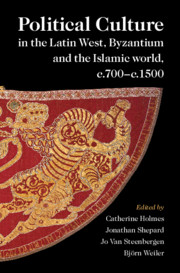 Political Culture in the Latin West, Byzantium and the Islamic World, c.700–c.1500
Political Culture in the Latin West, Byzantium and the Islamic World, c.700–c.1500 Book contents
- Political Culture in the Latin West, Byzantium and the Islamic World, c.700–c.1500
- Political Culture in the Latin West, Byzantium and the Islamic World, c.700–c.1500
- Copyright page
- Contents
- Figures and Maps
- Contributors
- Preface and Acknowledgements
- Abbreviations
- General Maps
- 1 Political Culture in Three Spheres
- 2 Reflections on Political Culture in Three Spheres
- Part I Sources
- Part II Historical Contexts
- Part III Norms, Values and Their Propagation
- Part IV Practice and Organisation
- Part V Conclusions
- 16 Comparisons, Connections and Conclusions
- Appendix
- Glossary
- Index
16 - Comparisons, Connections and Conclusions
from Part V - Conclusions
Published online by Cambridge University Press: 11 August 2021
- Political Culture in the Latin West, Byzantium and the Islamic World, c.700–c.1500
- Political Culture in the Latin West, Byzantium and the Islamic World, c.700–c.1500
- Copyright page
- Contents
- Figures and Maps
- Contributors
- Preface and Acknowledgements
- Abbreviations
- General Maps
- 1 Political Culture in Three Spheres
- 2 Reflections on Political Culture in Three Spheres
- Part I Sources
- Part II Historical Contexts
- Part III Norms, Values and Their Propagation
- Part IV Practice and Organisation
- Part V Conclusions
- 16 Comparisons, Connections and Conclusions
- Appendix
- Glossary
- Index
Summary
The spheres’ fifteenth-century political cultures are compared with earlier periods. The west was catching up, with increasingly complex and documented administration. It also saw more lay literacy and political participation by broader bands of actors, with assemblies approving general taxes. Debate was possible in the other two spheres: Islam generally allowed for multilateral discussion on religious law, while ideals of governance were debated in late Byzantium. The west fractured along religious lines to an extent not seen elsewhere: once the clerical monopoly of divine mediation had been fundamentally challenged, the plethora of arms-bearing, landed elites perpetuated conflict. State monopoly of violence characterised Byzantium, while in the Nile-to-Oxus region, ‘men of the sword’ tended not to wage sectarian war. Around 1500, women seldom exercised formal sovereignty. But the centrality of the household as a basic social unit gave them extensive informal power. Charitable foundations were another stabiliser across the spheres. Byzantium’s Muscovite offshoot would expand, but the Ottomans’ disciplined militarism looked invincible against the fractious westerners.
- Type
- Chapter
- Information
- Political Culture in the Latin West, Byzantium and the Islamic World, c.700–c.1500A Framework for Comparing Three Spheres, pp. 489 - 505Publisher: Cambridge University PressPrint publication year: 2021


